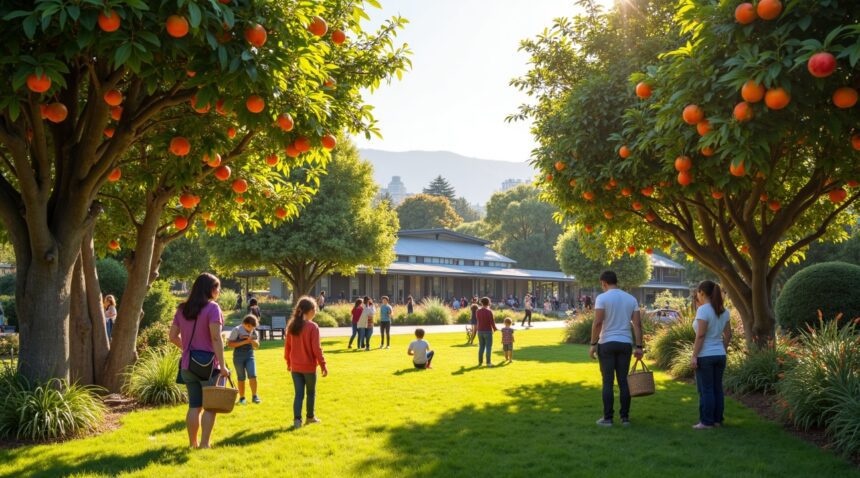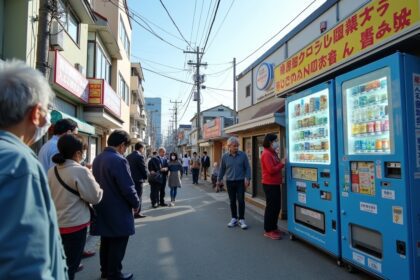New Zealand’s Nelson Marlborough District Health Board pioneered a groundbreaking approach to combat obesity and food insecurity by planting fruit and nut trees in public spaces where anyone can freely harvest fresh produce.
This innovative Open Orchards program has expanded nationwide, transforming parks, walkways, and community spaces across major cities from Nelson to Auckland into productive food sources that address public health concerns while strengthening community connections.
Key Takeaways
- Public fruit trees are strategically planted in parks, school grounds, river pathways, and community centers across New Zealand, with interactive digital maps helping residents locate harvestable fruit.
- The program features diverse species including apples, pears, citrus fruits, nuts like macadamias and walnuts, and native varieties like feijoa, providing year-round access to fresh produce.
- Responsible foraging practices encourage taking only what you need, selecting ripe fruit, avoiding tree damage, and reporting maintenance issues to local councils.
- Beyond free food access, these orchards create wildlife habitats, support pollinators, reduce urban heat, capture carbon, and foster community connections through shared harvesting experiences.
- Challenges include extreme weather damage, pest management, funding constraints, and the need for ongoing volunteer support and community education to ensure long-term sustainability.
The Open Orchards initiative represents more than just free food distribution. Community members develop deeper connections with their local environment while learning about sustainable food systems. Children discover where food originates, fostering healthier eating habits from an early age.
Community Involvement
Volunteering and Education
Councils partner with local schools and community groups to establish and maintain these productive spaces. Volunteers receive training in proper pruning techniques, harvest timing, and tree care. Educational workshops teach residents how to identify ripe fruit and preserve excess harvests for later use.
Success Stories from New Zealand
Success stories emerge from communities across New Zealand. Auckland’s Western Springs has seen increased park usage and stronger neighborhood bonds since installing their community orchard. Wellington residents report improved food security and reduced grocery expenses through regular harvesting activities.
Funding and Future Expansion
Local governments continue expanding the program despite budget limitations. Creative funding solutions include corporate sponsorships, community fundraising events, and partnerships with environmental organizations. Grant applications often succeed when proposals emphasize multiple benefits: food security, environmental improvement, and community development.
Looking Ahead
Future expansion plans include establishing demonstration gardens, incorporating composting systems, and developing educational programs for schools. The initiative serves as a model for other countries seeking innovative solutions to urban food challenges while building stronger, more sustainable communities.
How New Zealand’s Public Orchards Started as a Bold Health Solution
I witnessed something remarkable unfold in New Zealand during the early 2000s. The Nelson Marlborough District Health Board took an unprecedented approach to combat the country’s growing obesity epidemic and address limited access to fresh produce. Rather than implementing traditional health campaigns, they planted fruit and nut trees directly in public spaces where everyone could freely harvest nutritious food.
This innovative concept transformed parks, walkways, and school grounds into productive food sources. The health board recognized that making fresh fruit readily available could create lasting changes in eating habits, particularly among children who often struggled to access healthy options. Their solution was elegantly simple: if people couldn’t afford fresh produce, bring the orchard to them.
The Open Orchards Program Takes Root
The Open Orchards program emerged as the flagship example of this grassroots movement. I found their approach refreshingly practical – instead of lecturing about nutrition, they provided direct access to wholesome food. Health organizations partnered with local councils and dedicated volunteers to establish these edible landscapes across communities.
These collaborative efforts addressed multiple challenges simultaneously:
- Food security concerns affecting low-income families
- Limited access to fresh produce in certain neighborhoods
- The need to encourage healthy eating habits from childhood
- Community engagement through shared gardening experiences
- Environmental benefits through increased urban green space
The program’s success relied heavily on community involvement. Volunteers maintained the trees, organized harvest events, and educated residents about proper fruit care. Local councils provided land and basic infrastructure, while health organizations offered expertise in nutrition and public wellness strategies.
This approach marked a significant departure from conventional city landscaping practices. Traditional urban planning typically favored ornamental trees that looked attractive but provided no nutritional value. The public orchard initiative proved that cities could maintain beautiful green spaces while simultaneously addressing public health concerns and food accessibility issues.
The program’s impact extended beyond individual health benefits. Communities discovered that shared food sources fostered stronger neighborhood connections and taught children valuable lessons about where food originates. Parents reported that their children became more interested in trying different fruits and vegetables after participating in community harvest activities.
These public orchards demonstrated that innovative thinking could tackle complex social issues through practical, sustainable solutions. By combining environmental consciousness with public health initiatives, New Zealand created a model that other countries began studying and adapting for their own communities.
From Nelson to Auckland: Where You Can Find Free Fruit Trees Across New Zealand
Free fruit trees dot the landscape across New Zealand’s major cities and regions, creating an expansive network of edible resources for communities. I’ve discovered that these community orchards stretch from the Top of the South through to the North Island’s largest urban centers, making fresh fruit accessible to residents and visitors alike.
Strategic Locations for Maximum Community Access
Public fruit trees flourish in carefully chosen locations that maximize accessibility and community benefit. These plantings appear in several key areas:
- Public parks where families gather for recreation and relaxation
- River pathways that attract regular walkers and cyclists
- School grounds and nearby areas where children can learn about sustainable food systems
- Community recreation centers that serve as neighborhood hubs
- Council reserves and green spaces throughout residential areas
The Top of the South region leads this initiative, with Nelson, Marlborough, and Tasman districts establishing comprehensive fruit tree programs. Moving north, Palmerston North has embraced this concept, followed by New Plymouth’s coastal community efforts. Auckland, as New Zealand’s largest city, has implemented widespread plantings across multiple suburbs and districts.
The Nelson Community Organic Gardens Trust stands out as a key community organization driving these efforts forward. This group coordinates planting initiatives while educating residents about sustainable gardening practices and food security. Their work demonstrates how innovative community projects can transform urban landscapes.
Local councils have recognized the value of these initiatives by developing interactive fruit tree maps. These digital resources guide residents to specific locations where fruit trees are ready for harvesting. The maps typically include details about fruit varieties, ripening seasons, and picking guidelines to ensure sustainable use.
Major city councils have stepped beyond simple approval, actively funding maintenance programs that keep trees healthy and productive. This financial support covers:
- Pruning
- Pest management
- Replacement of damaged trees
Council involvement ensures that community members can safely access these resources without concerns about tree maintenance or fruit quality.
The geographic spread of these plantings creates opportunities for residents across diverse communities to participate. From Nelson’s established orchards to Auckland’s expanding network, New Zealand’s fruit tree initiative demonstrates how forward-thinking programs can address food accessibility while building stronger communities. Each location offers unique varieties suited to local growing conditions, ensuring year-round availability of fresh fruit across different regions.
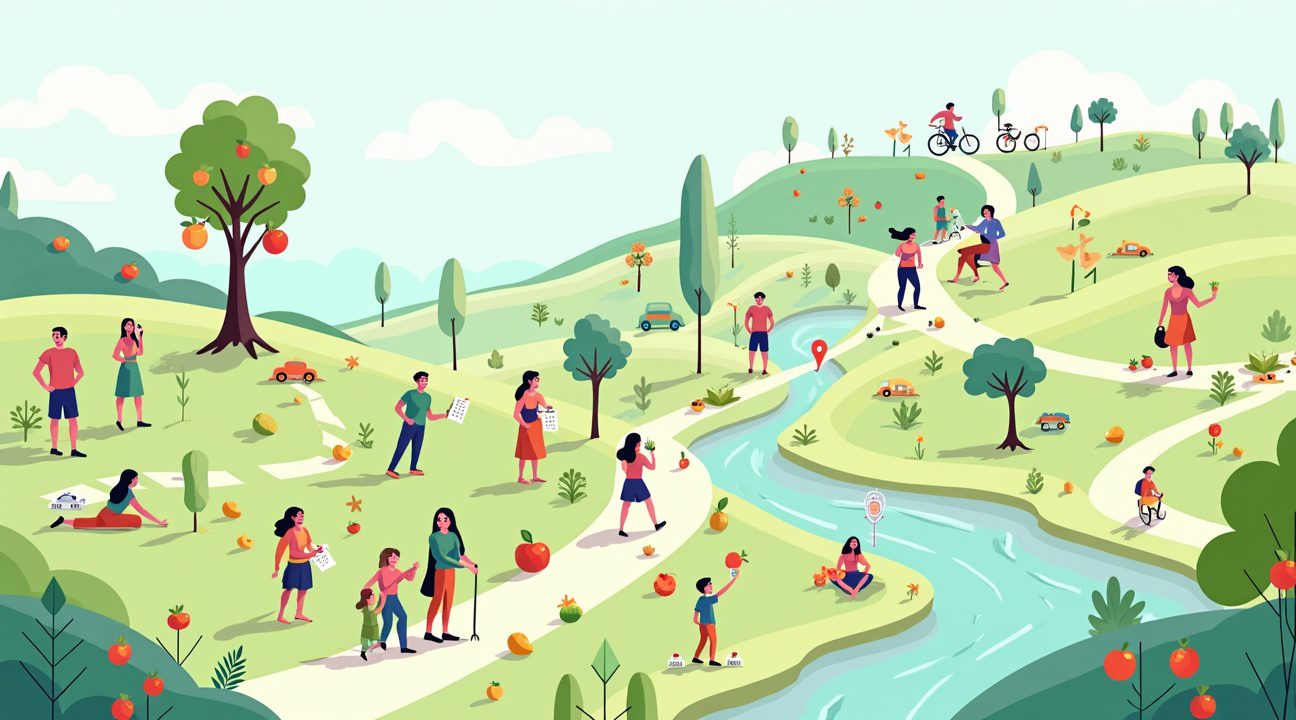
What You’ll Find Growing: From Apples to Macadamias in Public Spaces
I’ve discovered an impressive variety of fruit and nut trees flourishing throughout New Zealand’s public parks, creating year-round opportunities for free, fresh produce. The diversity extends far beyond traditional orchards, encompassing both familiar favorites and unique regional specialties that transform community spaces into productive food forests.
The Complete Range of Public Fruit Trees
Public parks across New Zealand now feature an extensive selection of edible species that cater to different tastes and nutritional needs. Apple trees remain among the most popular choices, offering harvest opportunities from January through April. Pear trees follow closely, with their fruit ready for picking between February and May. Stone fruits add summer sweetness to these spaces, with peaches, plums, and apricots ripening during the warmer months.
Citrus varieties bring year-round color and vitamin C to public spaces through lemon, mandarin, and orange trees. Fig trees provide their unique sweet offerings, while feijoa trees contribute distinctly New Zealand flavors that visitors often discover for the first time. Persimmon trees add autumn interest with their bright orange fruit that sweetens after the first frost.
The inclusion of nuts expands the protein and healthy fat options available to park visitors:
- Walnut trees provide substantial nutrition
- Macadamia trees offer premium nuts that would otherwise be expensive purchases
- Avocado trees bridge the gap between fruit and vegetable gardens, producing creamy, nutrient-dense fruit available from July through January
Seasonal Harvesting and Year-Round Benefits
Each species follows its own natural rhythm, creating a continuous cycle of fresh food availability throughout the year. This staggered ripening pattern ensures that community members can find something ready to harvest regardless of the season.
Seasonal highlights include:
- Summer: Stone fruit harvests (peaches, plums, apricots)
- Autumn: Apples, pears, persimmons
- Winter: Citrus fruits (oranges, mandarins, lemons)
- Spring: Early varieties marking the cycle’s renewal
The nutritional diversity available through these public plantings significantly enhances community health options. Different fruits provide varying combinations of vitamins, minerals, antioxidants, and fiber that support balanced diets:
- Citrus fruits: Rich in vitamin C
- Stone fruits: Source of potassium and beta-carotene
- Nuts: Provide protein and beneficial fats
Beyond human nutrition, this diverse planting strategy strengthens local ecosystems in remarkable ways. Different flowering periods support pollinators throughout extended seasons, while varied root systems improve soil health and prevent erosion. The mix of deciduous and evergreen species creates habitat diversity that attracts different bird species and beneficial insects.
These plantings also build resilience into urban food systems by reducing dependence on commercial agriculture and long-distance food transport. Local biodiversity initiatives like these demonstrate how communities can create sustainable food sources while enhancing environmental health.
The variety ensures that weather events or pest issues affecting one species won’t eliminate all food sources simultaneously. This redundancy creates more stable food availability for both human communities and wildlife populations that depend on these resources.
I find the integration of native species like feijoa particularly valuable, as these trees require less water and maintenance while providing unique flavors that connect people to local food traditions. The combination of familiar international varieties with regional specialties creates educational opportunities that expand palates and cultural understanding.
Through careful species selection and strategic planting schedules, New Zealand’s public fruit tree initiative transforms ordinary parks into productive landscapes that feed communities while supporting environmental health. This approach demonstrates how urban planning can simultaneously address food security, nutrition access, and ecological sustainability through thoughtful integration of edible species into public spaces.
The Unwritten Rules: How to Forage Responsibly in Public Orchards
Local councils across New Zealand actively promote responsible foraging practices that keep public orchards thriving for generations. These guidelines aren’t just suggestions—they’re essential principles that protect both the trees and the community resources everyone shares.
Core Harvesting Principles
Smart foraging starts with taking only what you’ll actually consume. I recommend picking fruit based on your immediate needs rather than filling every available container. This approach ensures enough produce remains for other community members while preventing unnecessary waste.
Ripe fruit identification becomes crucial for successful foraging. Choose fruits that yield slightly to gentle pressure and display their characteristic colors. Leave unripe specimens on branches where they’ll continue developing, and avoid overripe fruit that’s already started breaking down naturally. This selective harvesting maintains the orchard’s natural cycle while providing you with the best-tasting produce.
Tree and landscape preservation requires careful handling during collection. Avoid pulling branches downward or climbing trees, as this can damage bark and break limbs. Instead, use gentle twisting motions to detach fruit, and stick to what’s reachable from ground level. Never use tools that might harm the bark or disturb root systems.
Safety and Community Considerations
Safety awareness protects both foragers and the broader community. Stay alert around traffic when orchards border busy roads, and watch for uneven ground that could cause trips or falls. Some locations might have irrigation systems or maintenance equipment that requires careful navigation.
Community-minded practices strengthen these programs and build lasting goodwill. Consider these positive foraging behaviors:
- Bring reusable bags or containers to minimize environmental impact
- Share surplus fruit with neighbors, food banks, or community groups
- Report diseased, damaged, or vandalized trees to local council offices
- Keep harvest areas clean by removing any dropped fruit or debris
- Respect peak harvesting times by visiting during less crowded periods
Tree health monitoring helps councils maintain productive orchards year-round. I’ve noticed that early reporting of pest issues or disease symptoms can prevent widespread problems that might threaten entire groves. Most councils provide contact information on signage near these public spaces, making it easy to communicate concerns quickly.
These practices create a sustainable cycle where everyone benefits from abundant, free produce while protecting the investment councils have made in community food security. Creative community initiatives often emerge from these shared spaces, fostering connections between neighbors who might never have met otherwise.
Responsible foraging transforms a simple food collection activity into an act of environmental stewardship and community building. Following these guidelines ensures that New Zealand’s public orchards continue providing fresh, accessible nutrition for families across all income levels while maintaining the natural beauty these spaces bring to urban environments.
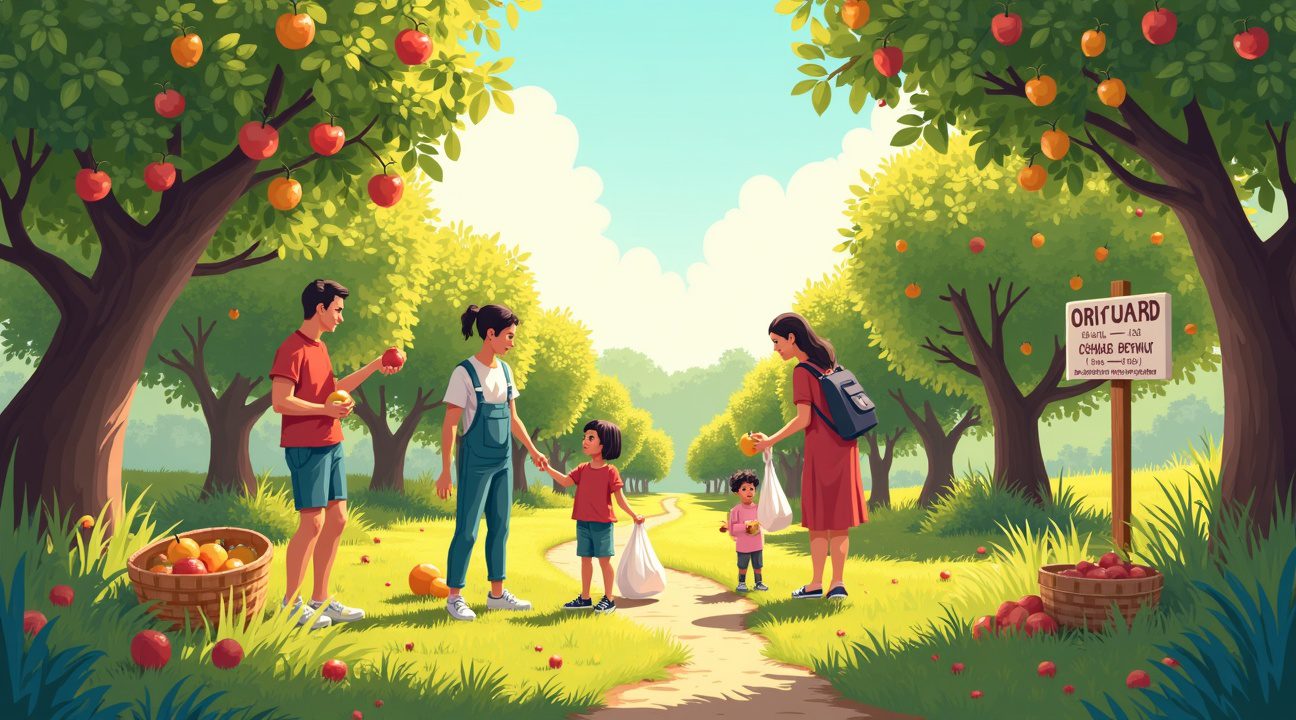
Beyond Free Food: How Public Fruit Trees Transform Communities and Environment
Public fruit trees create ecosystems that extend far beyond simple food provision. I’ve observed how these community orchards actively support urban biodiversity by establishing critical habitats for birds, bees, and countless beneficial insects. These green spaces function as informal wildlife corridors, connecting fragmented urban environments and expanding the available green infrastructure throughout cities.
The ecosystem services provided by these fruit trees demonstrate their value extends into environmental stewardship. Trees offer essential shade provision during increasingly hot summers while simultaneously capturing carbon from the atmosphere. Each mature fruit tree can absorb approximately 48 pounds of carbon dioxide annually, making these community projects powerful tools for climate action at the local level.
Ecological Benefits That Surpass Traditional Landscaping
Unlike monoculture agriculture or standard ornamental city landscaping, fruit tree plantings deliver significantly greater ecological and social benefits. I’ve seen measured increases in local wildlife and pollinator populations wherever edible landscaping gets adopted. These diverse plantings support bee colonies, butterfly populations, and bird species that struggle to find adequate resources in conventional urban environments.
Traditional ornamental trees often provide limited ecological value, focusing primarily on visual appeal rather than supporting local ecosystems. Fruit trees, however, offer multiple seasons of interest with spring blossoms attracting pollinators, summer foliage providing cooling shade, autumn fruit supporting both human and animal populations, and winter branch structures offering nesting sites for birds.
Community Connection and Social Impact
These projects help reconnect people with nature while promoting outdoor activity and meaningful social interaction. I observe families teaching children about seasonal cycles, neighbors sharing harvesting tips, and communities gathering around these productive spaces. The act of caring for and harvesting from public fruit trees creates shared experiences that strengthen neighborhood bonds.
The movement has grown steadily since the early 2000s, with dozens of community orchards now established nationwide across New Zealand. Auckland alone features hundreds of fruit trees in public parks, all documented through digital tree maps that help residents locate and access these free food sources. This systematic approach ensures communities can maximize the benefits from these investments.
While New Zealand ranks among the world’s top ten apple exporters with over 11,000 hectares of commercial orchards, these community efforts focus exclusively on feeding local populations through free access programs. The distinction matters because commercial orchards prioritize export markets and profit margins, while community fruit trees prioritize local food security and environmental benefits.
The environmental impact compounds over time as trees mature and expand their canopy coverage. Larger trees provide more substantial shade, capture greater amounts of carbon, and support larger populations of beneficial insects and birds. I’ve noticed that established community orchards become biodiversity hotspots that attract species rarely seen in other urban areas.
These initiatives also address urban heat island effects by increasing tree canopy coverage in neighborhoods that often lack adequate green space. Fruit trees planted in strategic locations can reduce local temperatures by several degrees during summer months, creating more comfortable outdoor environments for residents while reducing energy costs for nearby buildings.
The educational opportunities presented by public fruit trees shouldn’t be underestimated. Children learn about plant life cycles, seasonal changes, and sustainable food systems through direct observation and participation. Adults rediscover connections to food production that many urban dwellers have lost, fostering greater appreciation for agricultural processes and environmental stewardship.
Community orchards create spaces for intergenerational knowledge transfer, where experienced gardeners share pruning techniques, harvesting wisdom, and seasonal care practices with newcomers. These informal education networks strengthen community resilience while preserving traditional horticultural knowledge that might otherwise disappear in urban environments.
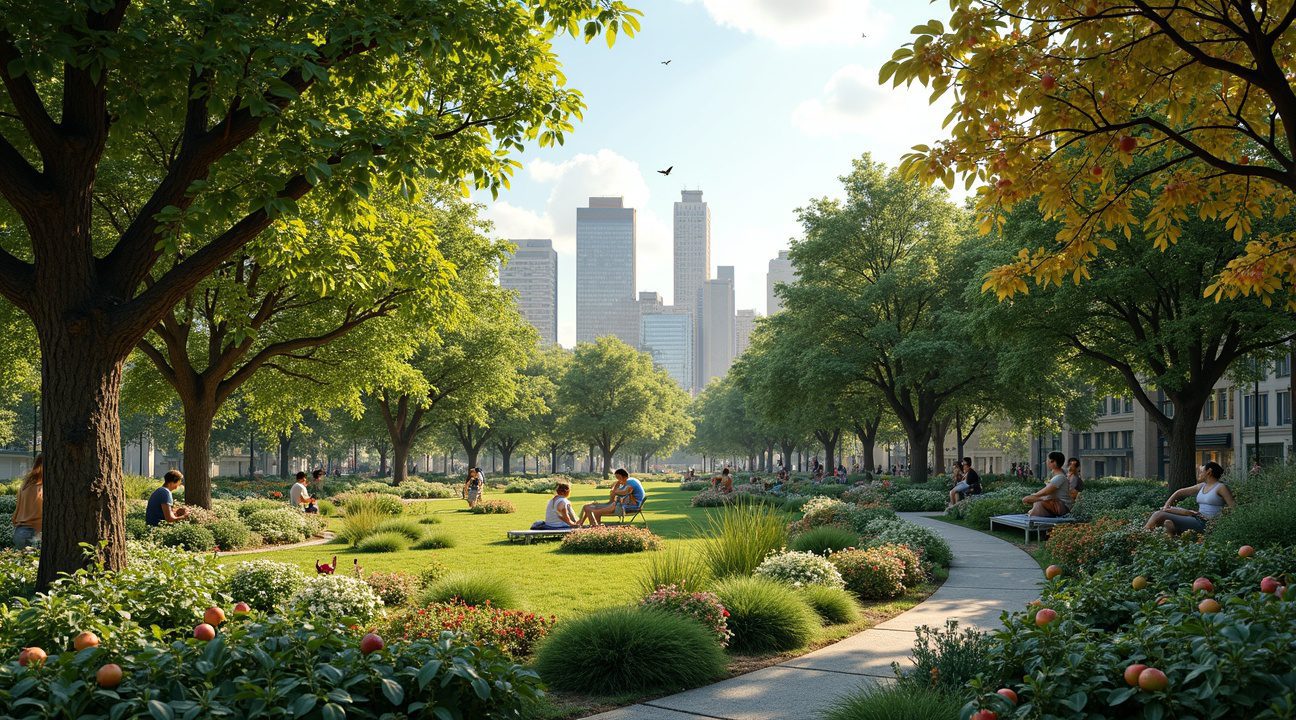
Weathering the Storms: Challenges and Future of Public Orchards
New Zealand’s public orchards face significant challenges that test their resilience and long-term viability. Extreme weather events pose one of the most serious threats to these community food sources. Cyclone Gabrielle in 2023 damaged several orchards across the country, disrupting fruit availability and creating extensive maintenance needs that required costly replanting efforts.
Environmental and Operational Obstacles
Climate variability continues to affect harvest timing, creating unpredictable fruit seasons that challenge both maintenance schedules and community expectations. Pest infestations regularly threaten tree health, requiring integrated management strategies that balance environmental protection with effective control measures. These challenges demand consistent attention and resources that stretch beyond what many communities initially anticipate.
Inconsistent funding streams create additional pressure on orchard sustainability. Local councils, health organizations, and volunteer groups must work together to secure ongoing financial support, yet budget constraints often limit expansion and proper maintenance. I’ve observed how successful orchards depend heavily on this collaborative approach, where multiple stakeholders contribute different resources and expertise.
Building Sustainable Community Support
Education and community engagement form the backbone of successful public orchards. Volunteer programs teach residents essential skills like pruning, pest management, and seasonal care while fostering ownership and pride in these shared spaces. Regular workshops and community events help maintain active participation levels that these projects require.
Environmental awareness campaigns strengthen public support by connecting orchard benefits to broader sustainability goals. Communities that understand how fruit trees contribute to carbon sequestration, biodiversity, and food security show greater willingness to invest time and resources in maintenance activities.
Long-term sustainability depends on developing reliable stewardship models that can adapt to changing conditions. Some orchards have established formal adoption programs where neighborhood groups take responsibility for specific sections, creating accountability and ensuring consistent care. This distributed approach reduces pressure on any single organization while building deeper community connections.
The future success of public orchards requires strategic planning that accounts for climate change impacts and evolving community needs. Investment in:
- Resilient tree varieties
- Improved irrigation systems
- Comprehensive volunteer training programs
will determine whether these valuable food sources can continue serving New Zealand communities for generations to come.
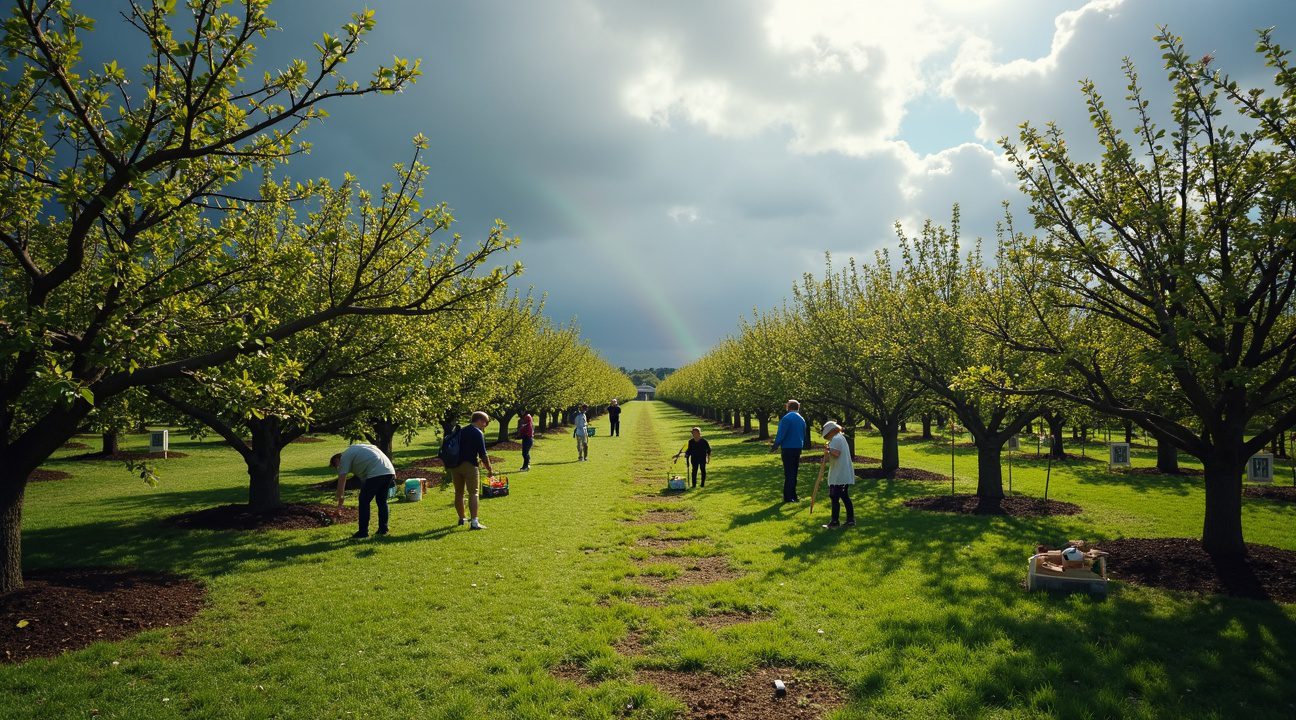
Sources:
Free Jupiter – “New Zealand Plants Fruit Trees in Public Spaces So Everyone Has Access to Fresh Fruit for Free”
Live Lightly – “Tāmaki Makaurau Fruit Tree Map”
Palmerston North City Council – “Community Orchards”
New Plymouth District Council – “Community Orchards”

